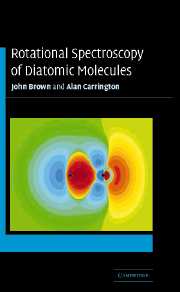Book contents
- Frontmatter
- Contents
- Preface
- Summary of notation
- Figure acknowledgements
- 1 General introduction
- 2 The separation of nuclear and electronic motion
- 3 The electronic Hamiltonian
- 4 Interactions arising from nuclear magnetic and electric moments
- 5 Angular momentum theory and spherical tensor algebra
- 6 Electronic and vibrational states
- 7 Derivation of the effective Hamiltonian
- 8 Molecular beam magnetic and electric resonance
- 9 Microwave and far-infrared magnetic resonance
- 10 Pure rotational spectroscopy
- 11 Double resonance spectroscopy
- General appendices
- Author index
- Subject index
- References
8 - Molecular beam magnetic and electric resonance
Published online by Cambridge University Press: 17 December 2010
- Frontmatter
- Contents
- Preface
- Summary of notation
- Figure acknowledgements
- 1 General introduction
- 2 The separation of nuclear and electronic motion
- 3 The electronic Hamiltonian
- 4 Interactions arising from nuclear magnetic and electric moments
- 5 Angular momentum theory and spherical tensor algebra
- 6 Electronic and vibrational states
- 7 Derivation of the effective Hamiltonian
- 8 Molecular beam magnetic and electric resonance
- 9 Microwave and far-infrared magnetic resonance
- 10 Pure rotational spectroscopy
- 11 Double resonance spectroscopy
- General appendices
- Author index
- Subject index
- References
Summary
Introduction
We have seen that the fine and hyperfine structure of vibration–rotation levels arises almost entirely from interactions involving electron spin, nuclear spin, and the rotational motion of the nuclei, with or without the additional presence of applied magnetic or electric fields. In this chapter we concentrate on the study of direct transitions between rotational, fine or hyperfine energy levels. Such transitions occur mainly in those regions of the spectrum which extend from the radiofrequency, through the microwave and millimetre wave, to the far infrared region. They are therefore transitions that involve very low energy photons, with the absorption or emission of very small amounts of energy. Specialised techniques have been developed to carry out spectroscopic studies in this frequency range. In particular one often does not attempt to detect the low energy photons directly, but to make use of indirect detection methods which rely on the energy level population transfer resulting from spectroscopic transitions. We shall describe a number of the indirect methods which have been employed.
Radiofrequency spectroscopy, in particular, is frequently combined with molecular beam techniques, or other methods using gas pressures which are low enough to remove the effects of molecular collisions. There are two main reasons for this. First, experiments which depend upon population transfer can only be successful if collisional relaxation or equilibration is absent.
- Type
- Chapter
- Information
- Rotational Spectroscopy of Diatomic Molecules , pp. 371 - 578Publisher: Cambridge University PressPrint publication year: 2003

